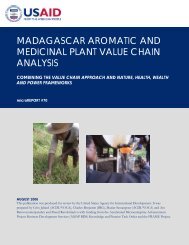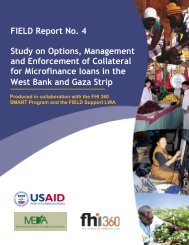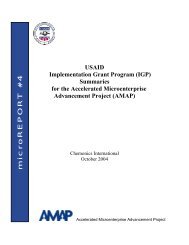End Market Analysis of Ethiopian Livestock and ... - USAID Microlinks
End Market Analysis of Ethiopian Livestock and ... - USAID Microlinks
End Market Analysis of Ethiopian Livestock and ... - USAID Microlinks
Create successful ePaper yourself
Turn your PDF publications into a flip-book with our unique Google optimized e-Paper software.
VI. PRELIMINARY CONCLUSIONS<br />
AND RECOMMENDATIONS FOR<br />
FURTHER DATA COLLECTION AND<br />
ANALYSIS<br />
A. PRELIMINARY CONCLUSIONS<br />
This desk study on end markets for <strong>Ethiopian</strong> livestock <strong>and</strong> meat provides some useful insights into Ethiopia’s<br />
competitiveness in Middle Eastern markets <strong>and</strong> enables us to draw some preliminary conclusions:<br />
• Key factors constraining Ethiopia’s competitiveness are unreliability <strong>of</strong> supply <strong>and</strong> low quality <strong>of</strong> meat.<br />
These are largely a product <strong>of</strong> the supply/purchasing systems <strong>and</strong> abattoir/export operations, which must be<br />
addressed in order for exports to increase.<br />
• Unreliability <strong>of</strong> supply is a consequence <strong>of</strong> the lack <strong>of</strong> integration within the <strong>Ethiopian</strong> livestock value<br />
chain. This is due to traditional livestock production <strong>and</strong> marketing systems as well as the abattoirs’ specific<br />
purchasing systems. Increased vertical integration—through buyer-seller contracts or companies such as<br />
UGITSC that involve actors at different levels <strong>of</strong> the value chain—will enable better planning to meet the<br />
needs for the export market.<br />
• Low quality is due in large part to inadequate infrastructure <strong>and</strong> inappropriate h<strong>and</strong>ling practices at the<br />
slaughter <strong>and</strong> export stages. Investments in appropriate infrastructure <strong>and</strong> cooling equipment—particularly<br />
cold stores for meat at Bole airport—are critical to decrease the risk <strong>of</strong> bacterial contamination. The<br />
enforcement <strong>of</strong> proper animal <strong>and</strong> meat h<strong>and</strong>ling practices will also be an important factor in improving<br />
meat quality <strong>and</strong> enabling <strong>Ethiopian</strong> meat exporters to target higher-end markets within the Middle East.<br />
• The lack <strong>of</strong> refrigerated transport must be addressed in order for Ethiopia to enter the market for frozen<br />
meat. This will require investment in refrigerated (“reefer”) trucks for shipping boneless meat <strong>and</strong> carcasses<br />
overl<strong>and</strong> to Djibouti <strong>and</strong> Somali ports.<br />
• Ethiopia’s competitors within the Middle Eastern markets compete not only on price <strong>and</strong> quality, but<br />
also on other factors such as flexibility <strong>of</strong> payment terms, aggressive marketing <strong>and</strong> promotion, <strong>and</strong> export<br />
incentives. Public-private initiatives <strong>and</strong> strong governmental support for meat exports are critical to these<br />
countries’ competitiveness. These are measures that Ethiopia may seek to emulate in order to increase the<br />
competitiveness <strong>of</strong> its meat exports <strong>and</strong> ultimately target higher-end markets.<br />
• Accessing higher-end markets will require not only quality improvements for existing meat exports (e.g.<br />
shoat carcasses), but also technological upgrading for new products (boxed cuts, boneless beef <strong>and</strong> mutton,<br />
etc.). Investment in such upgrading must be encouraged, possibly with support provided through a<br />
strengthened <strong>Ethiopian</strong> Meat <strong>and</strong> Dairy Training Institute, in order for higher-end meat products from<br />
Ethiopia to target higher-end markets in the Gulf <strong>and</strong> Egypt. In order for this to occur, a greater in-depth<br />
END MARKET ANALYSIS OF ETHIOPIAN LIVESTOCK AND MEAT 39





